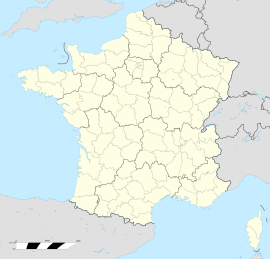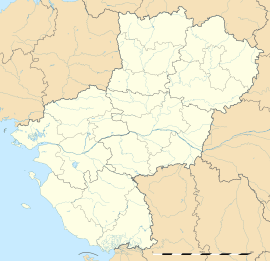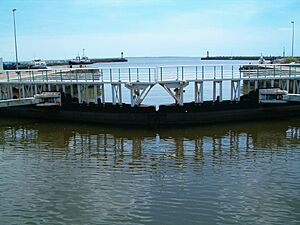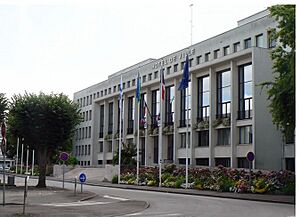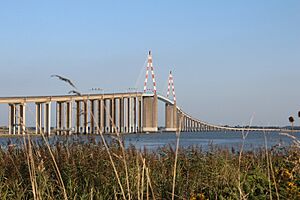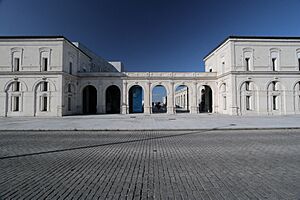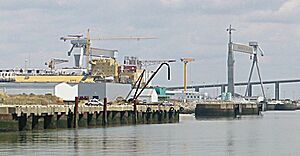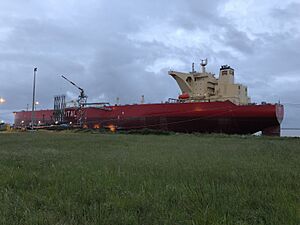Saint-Nazaire facts for kids
Quick facts for kids
Saint-Nazaire
|
|||
|---|---|---|---|
|
Subprefecture and commune
|
|||
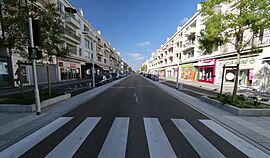
Avenue de la République
|
|||
|
|||
| Country | France | ||
| Region | Pays de la Loire | ||
| Department | Loire-Atlantique | ||
| Arrondissement | Saint-Nazaire | ||
| Canton | Saint-Nazaire-1 and 2 | ||
| Intercommunality | CA Région Nazairienne et Estuaire | ||
| Area
1
|
46.79 km2 (18.07 sq mi) | ||
| • Urban | 472.2 km2 (182.3 sq mi) | ||
| • Metro | 741 km2 (286 sq mi) | ||
| Population
(2022)
|
73,111 | ||
| • Density | 1,562.53/km2 (4,046.9/sq mi) | ||
| • Urban
(2018)
|
186,760 | ||
| • Urban density | 395.51/km2 (1,024.37/sq mi) | ||
| • Metro
(2018)
|
213,675 | ||
| • Metro density | 288.36/km2 (746.8/sq mi) | ||
| Time zone | UTC+01:00 (CET) | ||
| • Summer (DST) | UTC+02:00 (CEST) | ||
| INSEE/Postal code |
44184 /44600
|
||
| Elevation | 0–47 m (0–154 ft) (avg. 6 m or 20 ft) |
||
| 1 French Land Register data, which excludes lakes, ponds, glaciers > 1 km2 (0.386 sq mi or 247 acres) and river estuaries. | |||
Saint-Nazaire is a city in western France. It is located in the Loire-Atlantique area, which is part of traditional Brittany.
The city has a large harbour on the Loire estuary, which is where the river meets the Atlantic Ocean. Saint-Nazaire is also south of "la Brière", which is the second-largest swamp in France. Because of its location, Saint-Nazaire has always been important for fishing and shipbuilding. The Chantiers de l'Atlantique is one of the biggest shipyards in the world. It has built famous ocean liners like the SS Normandie, SS France, and the RMS Queen Mary 2. It also built the cruise ship MS Symphony of the Seas, which was the largest passenger ship in the world until 2022.
Saint-Nazaire was a small village for a long time. But it grew into a big city in the late 1800s. This happened because of new railways and the busy seaport. Saint-Nazaire slowly became the main port on the Loire estuary, taking over from the city of Nantes.
During World War II, Saint-Nazaire was a major base for German submarines. Because of this, it was attacked by the British in 1942. The city was also heavily bombed by the Allies until 1945. Saint-Nazaire was one of the last places in Europe to be freed from German control. This happened on May 11, 1945. The city was one of the most damaged in France during the war.
Contents
History of Saint-Nazaire
Ancient Times
Experts believe that Saint-Nazaire is built on top of an ancient city called Corbilo. This was a Gaulish city, and some say it was the second-largest Gaulish city after Marseille. People have lived in this area since at least the Stone Age. This is shown by old monuments like the tumulus of Dissignac and a dolmen in the city center.
Stories say that Brutus of Troy, a legendary ancestor of the Bretons, landed in Saint-Nazaire. Later, at the end of the Roman Empire, some Britons settled near the Loire estuary. The Breton language was spoken as far east as Donges, near Saint-Nazaire.
Middle Ages
A writer from the 500s, Gregory of Tours, wrote that the Roman Church kept the remains of a saint named Nazarius in a church here. Legend says that a Breton chief tried to steal these relics. But he hurt himself, and saw it as a miracle. After that, the village was named Sanctus Nazarius de Sinuario.
Not much is known about Saint-Nazaire during the Dark Ages. There were battles, like in 1380. During the Hundred Years' War, Jehan d'Ust defended the city against a Spanish fleet. After this, Saint-Nazaire became the center of a large area, including Penhoët and Pornichet.
Like all of Brittany, Saint-Nazaire was part of the Duchy of Brittany until 1532. Then, it became part of France. In 1756, a fort was built to protect the town, which had about 600 people. Saint-Nazaire was part of the province of Brittany until the French Revolution.
Growth in the 1800s
At the start of the 1800s, the port of Saint-Nazaire was just a simple harbor. It was not mainly for fishing. Instead, it was important because it was the furthest point inland where large ships could go. It also provided pilots to guide ships further up the Loire River. In 1800, Saint-Nazaire had 3,216 people.
The modern city of Saint-Nazaire grew a lot under Napoleon III. Its population grew very quickly. People even called it "Little Breton California" or "Liverpool of the West."
In 1802, a road was built to help the port grow. By 1835, a breakwater with a lighthouse was added. New basins were built for ships to unload goods onto barges. These barges then carried the goods up the river. This made Saint-Nazaire a base for passenger steamships. It also became an alternative port for ships that could not reach Nantes.
In 1856, the first wet dock was dug. This allowed ships to dock and turn easily. This also led to the city's first railway connection. In 1857, a railway connected Saint-Nazaire to Nantes. In 1862, the first transatlantic telegraph lines from France to South America came ashore at Saint-Nazaire. Also in 1862, major shipbuilding facilities were built. These included Chantier Scott, which built France's first metal-hulled ships. In 1868, Saint-Nazaire became a sub-prefecture. A second dock basin was built at Penhoët in 1881 for larger ships. But a lock gate built to access it split the town in two. This created Old Saint-Nazaire and an artificial island called "Little Morocco."
In 1894, a strike happened at the Trignac forging mills. This was because workers were being laid off. The dispute grew after a shooting in Fourmies. This led to Saint-Nazaire being called the "Red City" nationally. Socialists came to the town to support the striking workers.
In 1900, the area of Pornichet became its own separate town.
World War I
During World War I, Saint-Nazaire became a very important port. Allied troops, especially from the United States Army, landed here. When the US entered the war in 1917, they improved the port. They added more drinking water storage and a refrigeration terminal. This helped supply their troops with meat and dairy products.
Between the World Wars
After World War I, the shipbuilders faced tough times. So, they started building seaplanes from 1922. In 1926, the area of Paimbœuf joined with Saint-Nazaire. This made Saint-Nazaire more important on the south side of the Loire River.
The French government started projects to help the economy during the 1930s Great Depression. The state-owned shipping company ordered a new large passenger ship from Saint-Nazaire. Because of this, between 1928 and 1934, the Louis Joubert dry dock was built. It was 1,200 meters long and 60 meters wide. This was the largest dry dock in the world at the time. It was needed to build the SS Normandie. In 1932, the Saint-Nazaire casino went out of business. It was sold to Nantes, and in 1935, it became the first home of the Saint-Louis school.
In June 1936, there was a national strike. To make sure the important SS Normandie project was finished, the government took over the private shipyards. They combined them into one state-owned company, the Chantiers de l'Atlantique.
World War II
After Nazi Germany invaded Poland at the start of World War II, French and British forces could not stop them. Saint-Nazaire became a place where British troops could evacuate to England. The writer John Renshaw Starr was among those who left from here.
Sinking of the Lancastria
On June 17, 1940, about 9,000 British soldiers were on a ship called the RMS Lancastria. German bombers attacked and sank the ship. Around 4,000 people died. This was the worst disaster in British maritime history. It was also the biggest loss of life for British forces in all of World War II. Winston Churchill did not allow news about this disaster to be shared. Because of this, it is often forgotten. There is a Lancastria memorial near the U-boat pens in Saint-Nazaire.
The Miracle of Saint-Nazaire
An amazing event happened during the war. A gunner from an American B-17F bomber fell 20,000 feet (about 6,100 meters) onto the glass roof of the train station. His parachute had been destroyed by German anti-aircraft fire while he was still in his plane. But the US airman, Alan Magee, survived the fall. A German military doctor was able to save his arm, which was almost cut off. The airman said he survived because he prayed to God as he fell.
U-boat Pens

After France surrendered to Germany in June 1940, the port became a base for the German navy (the Kriegsmarine). Because of this, the Allies targeted it. A very strong U-boat Saint-Nazaire submarine base was built by the Organisation Todt. It had a concrete ceiling 9 meters (30 feet) thick. This could withstand almost any bomb used at the time.
Many famous U-boat commanders were based here during the war. These included Commander Georg-Wilhelm Schulz and Kapitänleutnant Carl Emmermann.
The U-boat base is still standing today. It was built so strongly that it is too expensive to tear down. Now, the base has cafes and a bar. There is also an exhibition about Saint-Nazaire on its roof.
The St Nazaire Raid
The huge Joubert dry dock, built for the SS Normandie, was the only port on the Atlantic that could fix the German battleships Bismarck and Tirpitz. This made the port very important for both sides during World War II. After the sinking of the British ship HMS Hood and the German ship Bismarck in May 1941, the Allies needed to stop the Germans from using the Joubert dry dock. On March 28, 1942, 611 British Commandos and the Royal Navy launched the St Nazaire Raid. This attack was called Operation Chariot. An old American destroyer called HMS Campbeltown was filled with explosives and used to ram the dry dock. The ship and the Commandos successfully destroyed the gates and machinery of the dry dock. This stopped the Germans from using it for the rest of the war. Out of over 600 navy and commando personnel, 220 returned, and half of them were wounded. Many awards were given for bravery. The Joubert dry dock was not used again until 1948.
After Operation Chariot
German U-boats were a threat to supply convoys across the Atlantic. So, Saint-Nazaire was constantly bombed by Allied air forces. The German air force (the Luftwaffe) fought hard against these raids. On January 3, 1943, Colonel Curtis LeMay led 85 Boeing B-17 Flying Fortress bombers against the U-boat pens. This was the sixth raid by the Eighth Air Force on the base. LeMay also created a new defensive formation for bombers to protect them from fighter planes. Only 76 aircraft hit the target. During this mission, seven bombers were shot down and 47 were damaged.
After this raid, the Allies decided to use incendiary bombs against the U-boat pens. To keep civilians safe, the Allies planned to make people leave the town. For three days in 1943, British and American planes dropped leaflets. These leaflets warned people about a planned fire-bombing raid. On the third day, the raid happened and burned the entire city to the ground. Not many people were hurt because most civilians had listened to the warning and left for the countryside. After that, except for the U-boat base, Saint-Nazaire remained empty until the end of the war.
After D-day and the liberation of most of France in 1944, German troops in Saint-Nazaire's submarine base refused to surrender. They stayed hidden, just like German troops in La Rochelle and Lorient. Since the Germans could not run major submarine operations without supplies, the Allied commander, U.S. General Dwight D. Eisenhower, decided to simply go around these ports. The Allied armies focused on invading Germany. Saint-Nazaire and the other two German "pockets" stayed under German control until May 8, 1945, the last day of the war in Europe.
After World War II
The city of Saint-Nazaire was rebuilt in the late 1940s and 1950s. The buildings were simple and practical. One of the last buildings to be finished was the Hôtel de Ville (City Hall), which was completed in February 1960.
The submarine base was used by the French Navy from 1945 to 1948. Then, different chemical companies and shipbuilders used it. As of 2016, the French diesel submarine Espadon is docked inside the U-boat pens. People can take tours of the submarine.
After the SS France was built in 1961, the shipyards started building large oil tankers. These included Batillus and Queen Mary 2. The RMS Queen Mary 2 was built at Chantiers de l'Atlantique in 2003.
Geography
Saint-Nazaire is on the north side of the Loire estuary. This is where the Loire River meets the ocean. It is about 50 kilometers (31 miles) west of Nantes. The city is also close to the Brière marshes. This is an important natural park with many animals and plants. It is the second-largest wetland in France.
Saint-Nazaire is the main city of an "urban unit" (a group of connected towns). In 2018, this area had 186,760 people and included 17 towns. This urban unit is the center of the larger Saint-Nazaire urban area, which had 213,675 people in 2018. This area stretches over Brière and most of the Guérande peninsula. The eastern part of the city is on flat land between Brière and the Loire estuary. The western part is hillier and higher up. Saint-Nazaire is part of the Armorican massif, which is a geological region.
Climate
Saint-Nazaire is very close to the Atlantic Ocean. So, its climate is mild and oceanic. Winters are gentle, and summers are warm. Snow is rare, but rain happens often (about 116 days a year). However, the rain is usually not very heavy. The city gets about 789 millimeters (31 inches) of rain each year. The amount of rain can change from year to year. Saint-Nazaire gets about 1,892 hours of sunshine each year.
Saint-Nazaire mostly gets winds from the southwest. These winds are linked to Atlantic storms. When the weather is more stable, winds come from the northeast. The average wind speed is 4.5 meters per second (10 miles per hour). There are about 60 days a year with strong winds.
| Climate data for Saint Nazaire (1991-2020, extremes since 1962)Coordinates:47°19′N 2°10′W / 47.32°N 2.17°W | |||||||||||||
|---|---|---|---|---|---|---|---|---|---|---|---|---|---|
| Month | Jan | Feb | Mar | Apr | May | Jun | Jul | Aug | Sep | Oct | Nov | Dec | Year |
| Record high °C (°F) | 16.8 (62.2) |
20.7 (69.3) |
24.0 (75.2) |
27.5 (81.5) |
31.2 (88.2) |
37.7 (99.9) |
41.0 (105.8) |
38.4 (101.1) |
33.4 (92.1) |
29.4 (84.9) |
20.9 (69.6) |
16.9 (62.4) |
41.0 (105.8) |
| Mean daily maximum °C (°F) | 9.5 (49.1) |
10.4 (50.7) |
13.2 (55.8) |
15.8 (60.4) |
19.2 (66.6) |
22.5 (72.5) |
24.4 (75.9) |
24.5 (76.1) |
21.9 (71.4) |
17.4 (63.3) |
13.1 (55.6) |
10.2 (50.4) |
16.8 (62.3) |
| Daily mean °C (°F) | 6.6 (43.9) |
6.9 (44.4) |
9.1 (48.4) |
11.2 (52.2) |
14.5 (58.1) |
17.5 (63.5) |
19.3 (66.7) |
19.2 (66.6) |
16.7 (62.1) |
13.5 (56.3) |
9.6 (49.3) |
7.1 (44.8) |
12.6 (54.7) |
| Mean daily minimum °C (°F) | 3.7 (38.7) |
3.4 (38.1) |
5.1 (41.2) |
6.6 (43.9) |
9.8 (49.6) |
12.5 (54.5) |
14.1 (57.4) |
13.9 (57.0) |
11.4 (52.5) |
9.5 (49.1) |
6.1 (43.0) |
4.0 (39.2) |
8.3 (47.0) |
| Record low °C (°F) | −13.8 (7.2) |
−13.7 (7.3) |
−9.4 (15.1) |
−3.0 (26.6) |
−0.9 (30.4) |
2.0 (35.6) |
6.5 (43.7) |
4.7 (40.5) |
1.1 (34.0) |
−5.9 (21.4) |
−7.9 (17.8) |
−10.6 (12.9) |
−13.8 (7.2) |
| Average precipitation mm (inches) | 87.7 (3.45) |
68.3 (2.69) |
58.6 (2.31) |
56.6 (2.23) |
54.9 (2.16) |
40.0 (1.57) |
38.6 (1.52) |
44.1 (1.74) |
63.4 (2.50) |
87.7 (3.45) |
95.4 (3.76) |
96.7 (3.81) |
792 (31.19) |
| Average precipitation days (≥ 1 mm) | 12.5 | 10.2 | 9.3 | 9.2 | 8.9 | 7.6 | 7 | 6.5 | 7.9 | 11.4 | 12.8 | 13 | 116.3 |
| Mean monthly sunshine hours | 72.8 | 102 | 148.7 | 174.5 | 206.8 | 232.9 | 233.1 | 233.9 | 197.7 | 127.9 | 89.8 | 72.4 | 1,892.5 |
| Source: Infoclimat | |||||||||||||
Education
Schools in Saint-Nazaire
Saint-Nazaire has many primary schools. About 8,000 students attend these schools in 30 different complexes. There are also 12 junior high schools, with nearly 7,000 students. Public junior high schools like Albert Vinçon and Jean Moulin each have about 1,350 students. Private junior high schools include Saint-Louis and Sainte-Therese.
The city has 11 high schools, teaching 6,000 students. Aristide Briand is a large high school with about 2,500 students. There is also an experimental high school run by teachers and students together. The Cité Scolaire of Saint-Nazaire is one of the largest school complexes in France, with almost 4,000 high school students.
University Campus
The University of Saint-Nazaire is part of the University of Nantes. The University of Nantes is the second-largest university in France, with about 35,000 students. Nearly 5,000 of these students study at the Saint-Nazaire campus.
Transport
The Route nationale N165/N161 (E60 route) connects Saint-Nazaire to Nantes and Rennes. This road crosses the Loire River using the Pont de Saint-Nazaire. From Nantes, you can reach Paris by highway. Other cities like Valves, Lorient, Quimper, and Brest are reached via the N165.
There are plans to build a second bridge or crossing over the Loire between Nantes and Saint-Nazaire.
Railway Travel
The Saint-Nazaire railway station is served by both high-speed trains (TGV) and regional trains and buses. The TGV connects Saint-Nazaire to Paris, Lyon, Marseille, Lille, and Strasbourg. A trip to Paris on the LGV Atlantique takes just over 2 hours. Regional trains connect to Nantes, Angers, Le Mans, La Roche sur Yon, and other nearby towns.
Air Travel
Saint-Nazaire airport is about 5 kilometers (3 miles) southeast of the city. It is in the town of Montoir-de-Bretagne. This airport can handle about 150,000 passengers each year. It is also a base for Eagle Aviation France.
For international travel, people use Nantes Atlantique Airport. This is the biggest airport in western France. It has flights to many French and European cities. It also has seasonal flights to Montreal in Canada and some cities in North Africa.
Economy
The city's economy is mostly based on its port. This includes exporting manufactured goods and providing services. Commercial fishing has almost disappeared, even though there is a small fishing fleet.
Saint-Nazaire faced economic challenges in the 1960s and 1970s. This was because shipbuilding slowed down in western Europe after the SS France was completed. For a long time in the 1980s, Saint-Nazaire had high unemployment rates, sometimes over 20%. Today, the local economy is more varied. Its situation is now similar to the rest of France. The main industries are:
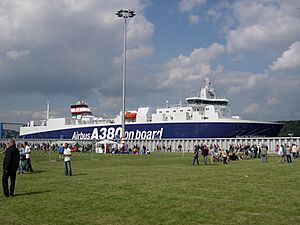
- Shipbuilding – Chantiers de l'Atlantique used to build naval and cargo ships. Now, it mainly builds cruise ships and is a world leader in this area. The RMS Queen Mary 2 was built here.
- Airbus – Saint-Nazaire is one of the European centers for Airbus. Workers here fit together parts of aircraft bodies. The Ville de Bordeaux ship brings large fuselage sections for the Airbus A380 from Hamburg, Germany. It also picks up wings from England and Wales. These parts are then transported by barge and special road convoys to the assembly hall in Toulouse.
- Aeronautical Engineering – Famat is a company that makes parts for turbojet engines. It has a factory in Saint-Nazaire and employs about 450 people.
- Mechanical Engineering – SEMT Pielstick makes diesel engines for ships, trains, and for producing electricity. In 2006, the SEMT Pielstick factory in Saint-Nazaire employed 670 people.
- Port – Saint-Nazaire has the main French port on the Atlantic coast. It is now busier than Nantes. The port handles a lot of food products, methane, and oil.
Saint-Nazaire is home to France's first offshore wind farm. It has 80 wind turbines that will produce enough power for about 700,000 people.
International Relations
Twin Towns and Sister Cities
Saint-Nazaire is connected with these cities:
 Avilés, Spain
Avilés, Spain Saarlouis, Germany, since 1969
Saarlouis, Germany, since 1969 Sunderland, England, United Kingdom, since 1953
Sunderland, England, United Kingdom, since 1953
Cooperation Agreements
People from Saint-Nazaire
- René-Yves Creston (1898–1964), artist and ethnologist.
- Odette du Puigaudeau (1894–1991), an ethnologist.
- Fernand Guériff (1914–1994), a scholar and historian.
- Yann Goulet (1914–1999), a sculptor.
- Marie Léra (1864-1958), a journalist and novelist.
- Roger Lévêque, (1920–2002), a professional road racing cyclist.
- Colonel Moutarde (born 1968), an illustrator.
- Stéphane Hoffmann, (born 1958), a writer.
- Tony Heurtebis, (born 1975), a football goalkeeper.
- Pierre R. Graham (born 1922), a former US ambassador.
- Sandra Gomis (born 1983), an athlete.
- Bryan Coquard (born 1992), a professional cyclist and Olympic Silver medalist.
- Serge (born 2005), a llama who became famous after being "kidnapped" by students.
- Vincent Talio (born 1981), a footballer.
Demographics
| Historical population | ||||||||||||||||||||||||||||||||||||||||||||||||||||||||||||||||||||||||||||||||||||||||||||||||||||||||||||||||||||
|---|---|---|---|---|---|---|---|---|---|---|---|---|---|---|---|---|---|---|---|---|---|---|---|---|---|---|---|---|---|---|---|---|---|---|---|---|---|---|---|---|---|---|---|---|---|---|---|---|---|---|---|---|---|---|---|---|---|---|---|---|---|---|---|---|---|---|---|---|---|---|---|---|---|---|---|---|---|---|---|---|---|---|---|---|---|---|---|---|---|---|---|---|---|---|---|---|---|---|---|---|---|---|---|---|---|---|---|---|---|---|---|---|---|---|---|---|
|
|
|
||||||||||||||||||||||||||||||||||||||||||||||||||||||||||||||||||||||||||||||||||||||||||||||||||||||||||||||||||
| Source: EHESS and INSEE | ||||||||||||||||||||||||||||||||||||||||||||||||||||||||||||||||||||||||||||||||||||||||||||||||||||||||||||||||||||
Breton Language
In 2008, a small number of children (0.41%) attended primary schools where they learned in both French and Breton.
See also
 In Spanish: Saint-Nazaire para niños
In Spanish: Saint-Nazaire para niños
- Communes of the Loire-Atlantique department
- Parc naturel régional de Brière




